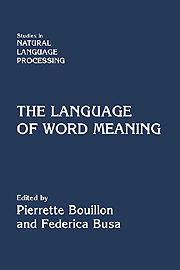Book contents
- Frontmatter
- Contents
- List of Contributors
- Preface
- Introduction: Word Meaning and Creativity
- Part I Linguistic Creativity and the Lexicon
- Part II The Syntax of Word Meaning
- Part III Interfacing the Lexicon
- 13 Introduction
- 14 Metaphor, Creative Understanding, and the Generative Lexicon
- 15 Metaphor in Discourse
- 16 Syntax and Metonymy
- 17 Generative Lexicon Meets Corpus Data: The Case of Nonstandard Word Uses
- Part IV Building Resources
- Index
16 - Syntax and Metonymy
Published online by Cambridge University Press: 07 October 2011
- Frontmatter
- Contents
- List of Contributors
- Preface
- Introduction: Word Meaning and Creativity
- Part I Linguistic Creativity and the Lexicon
- Part II The Syntax of Word Meaning
- Part III Interfacing the Lexicon
- 13 Introduction
- 14 Metaphor, Creative Understanding, and the Generative Lexicon
- 15 Metaphor in Discourse
- 16 Syntax and Metonymy
- 17 Generative Lexicon Meets Corpus Data: The Case of Nonstandard Word Uses
- Part IV Building Resources
- Index
Summary
Abstract
Metonymy is refering to one entity by describing a functionally related entity. When this is formalized in an Interpretation as Abduction framework, it can be seen that an isomorphic process solves a number of problems that have hitherto been viewed as syntactic. In these cases, the coercion function associated with the metonymy comes from material that is explicit in the sentence. For example, in “John smokes an occasional cigarette,” it is the smoking rather than the explicit argument of “occasional,” the cigarette, that is occasional; there is a coercion from the cigarette to the smoking event, where the coercion relation is provided by the “smokes” predication itself. Other phenomena analyzed in this manner are extraposed modifiers, container nouns, the collective-distributive ambiguity for some plural noun phrases, small clauses in disguise such as “This country needs literate citizens,” and the assertion of grammatically presupposed material. These examples lie on the boundaries between syntax, semantics, and pragmatics, and illustrate the utility of a framework in which the three areas are modeled in a uniform fashion.
Metonymy
Metonymy is the linguistic device by which an entity is referred to by refering to a functionally related entity. For example, when we say “John reads Proust” we really mean “John reads the novels by Proust.” We may say that “Proust” has been coerced into “the novels by Proust.” Alternatively, we may say that “read” has been coerced into “read the novels by.”
- Type
- Chapter
- Information
- The Language of Word Meaning , pp. 290 - 311Publisher: Cambridge University PressPrint publication year: 2001
- 5
- Cited by



